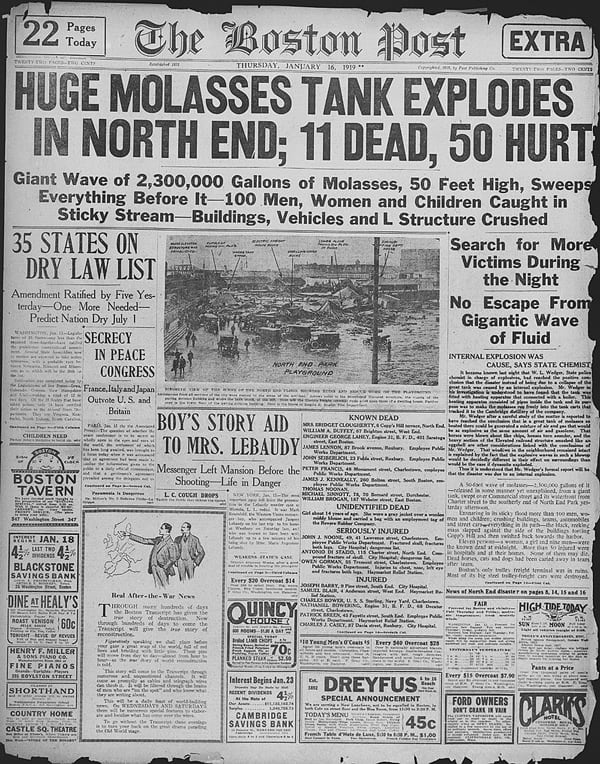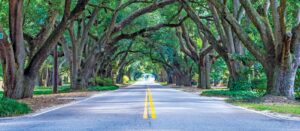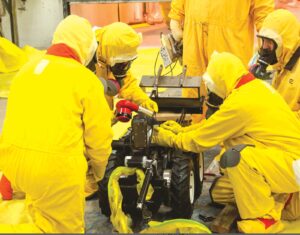Charleston, South Carolina had its own Tea Party incident on December 3, 1773, 13 days before the one in Boston.
You learned about the Boston Tea Party in school, did you not? It was no picnic — It was a protest against taxes imposed on the colonies by the British government.
No one was hurt, and no property was damaged. Except, that is, for the 342 crates of tea, about 45 tons, that were dumped into the Boston Harbor on December 16, 1773. I wonder whether all that tea turned the water in the harbor brown…
We think of food in small portions — a glass of wine, a slice of pie, a delicate cup of tea. But food is big industry. The contents of that bottle or jar or box on the grocery shelf was once the tiniest fraction of gallons and tons of the same substance stored in massive tanks and silos.
This story is about molasses.
Molasses is a by-product of the manufacture of sugar from sugarcane or sugar beets. One of its industrial applications is its fermentation to produce ethanol for use in alcoholic beverages and in the production of dynamite. The Purity Distilling Company had a large tank for molasses beside Boston Harbor, in the North End, which was largely inhabited by Irish and Italian immigrant laborers and their families. When needed, the molasses was then piped to Purity’s ethanol plant in Cambridge. The tank was built in 1915, during World War I, when dynamite was in great demand. While the demand for dynamite diminished once the war ended, the demand for alcohol grew — these were the years leading up to Prohibition.
The tank was 50’ high, 90’ in diameter, and held up to 2,300,000 gallons of sticky molasses. The tank was not structurally sound or tested. And it was not well maintained. It had so many leaks that it was painted brown so the leaks could not be seen. Local residents were known to collect molasses from the leaks for use in their homes.
What could possibly go wrong?
On the day in question, January 15, 1919, the tank was nearly full — a fresh shipment from the Caribbean had just been unloaded. A combination of temperature changes and structural lack of integrity caused the tank to burst open and collapse a little after noon. The ground shook. The sound of machine gun fire turned out to be caused by the rivets shooting out of the tank. The wave of molasses, initially close to 50’ high, swept through the busy streets at 35 mph. It tipped a streetcar off its tracks and hurled a truck into the Boston Harbor. Nearby buildings were pushed off their foundations and collapsed. People and horses were caught in the sticky wave; some were swept into the harbor. Molasses oozed through doors and windows and trapped people inside. It flooded several blocks in the area to a depth of 2 – 3’. It spread through the streets, into streetcars and trains, and into homes.
As the temperature started to cool, the molasses hardened and rescue became difficult.

The area of the disaster in the aftermath of the molasses flood. Photo courtesy of the Boston Public Library.
It was one sticky mess!
In the end, countless horses were killed, 150 people were injured, and 21 people, ages 10 – 78, lost their lives. There was nothing left of the tank.
A class action lawsuit was brought against the United States Industrial Alcohol Company (USIA), owner of the Purity Distilling Company. The USIA initially claimed the tank had been blown up by anarchists because the alcohol was used in making munitions. In the end the USIA was found guilty and paid $628,000 in damages.
Ironically, the 18th amendment, which banned the manufacture, sale, and transport of alcoholic beverages, was ratified the day after the Boston Molasses Disaster and went into effect one year later.
The water in the Boston Harbor was stained brown until summer, and molasses continued to seep out of the ground on warm summer days for years.

Headline in the Boston Post the day after, before the full extent of the destruction was known. Image in the public domain.
The molasses used as a sweetener for food, known in Great Britain as black treacle, is made from sugar cane. You will find it as an ingredient in gingerbread, barbecue sauces, dark breads, cookies, and pies. The primary ingredient in Shoofly Pie is molasses, along with flour, brown sugar (because the molasses is not sweet or sticky enough?), egg, and water. It “began as a crust-less molasses cake called Centennial Cake in 1876 to celebrate the 100th anniversary of the signing of the Declaration of Independence in Philadelphia.” Crusts were added later. My guess is that the pie got its name from the flies it attracted.
In the London Beer Flood of 1814, failing wooden vats at the Horseshoe Brewery released 150,000 – 400,000 gallons of fermenting porter (dark beer) into the streets. 8 deaths resulted, but the courts ruled the disaster an “Act of God” and did not hold Meux & Co, the owner of the brewery, liable.























